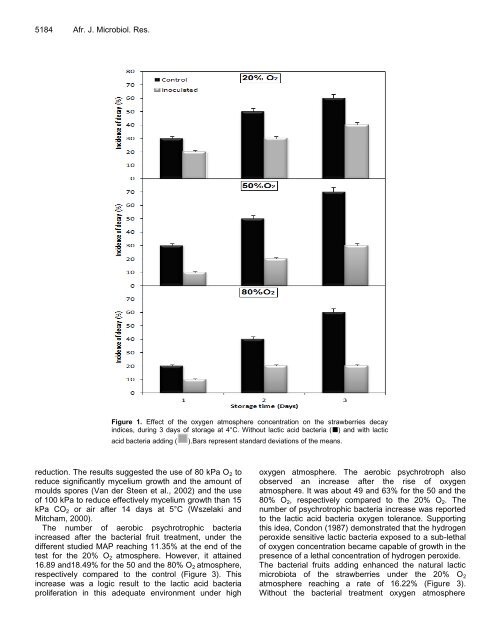Microbiology Research - Academic Journals
Microbiology Research - Academic Journals
Microbiology Research - Academic Journals
You also want an ePaper? Increase the reach of your titles
YUMPU automatically turns print PDFs into web optimized ePapers that Google loves.
5184 Afr. J. Microbiol. Res.<br />
Figure 1. Effect of the oxygen atmosphere concentration on the strawberries decay<br />
indices, during 3 days of storage at 4°C. Without lactic acid bacteria (�) and with lactic<br />
acid bacteria adding ( ).Bars represent standard deviations of the means.<br />
reduction. The results suggested the use of 80 kPa O2 to<br />
reduce significantly mycelium growth and the amount of<br />
moulds spores (Van der Steen et al., 2002) and the use<br />
of 100 kPa to reduce effectively mycelium growth than 15<br />
kPa CO2 or air after 14 days at 5°C (Wszelaki and<br />
Mitcham, 2000).<br />
The number of aerobic psychrotrophic bacteria<br />
increased after the bacterial fruit treatment, under the<br />
different studied MAP reaching 11.35% at the end of the<br />
test for the 20% O2 atmosphere. However, it attained<br />
16.89 and18.49% for the 50 and the 80% O2 atmosphere,<br />
respectively compared to the control (Figure 3). This<br />
increase was a logic result to the lactic acid bacteria<br />
proliferation in this adequate environment under high<br />
oxygen atmosphere. The aerobic psychrotroph also<br />
observed an increase after the rise of oxygen<br />
atmosphere. It was about 49 and 63% for the 50 and the<br />
80% O2, respectively compared to the 20% O2. The<br />
number of psychrotrophic bacteria increase was reported<br />
to the lactic acid bacteria oxygen tolerance. Supporting<br />
this idea, Condon (1987) demonstrated that the hydrogen<br />
peroxide sensitive lactic bacteria exposed to a sub-lethal<br />
of oxygen concentration became capable of growth in the<br />
presence of a lethal concentration of hydrogen peroxide.<br />
The bacterial fruits adding enhanced the natural lactic<br />
microbiota of the strawberries under the 20% O2<br />
atmosphere reaching a rate of 16.22% (Figure 3).<br />
Without the bacterial treatment oxygen atmosphere

















